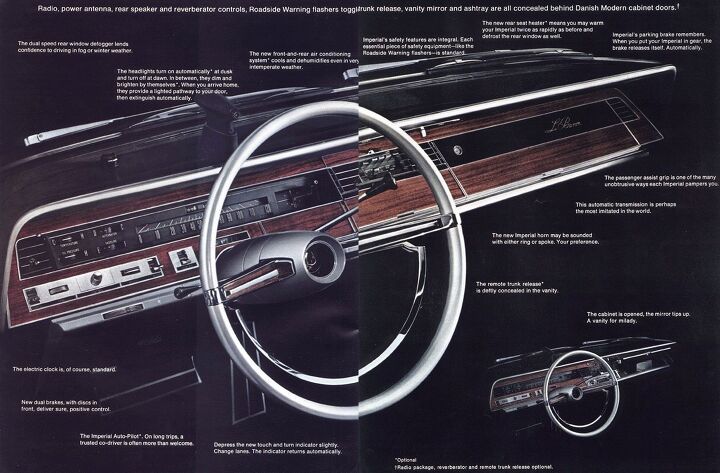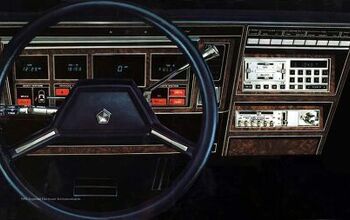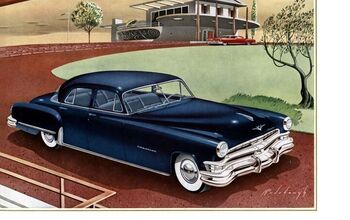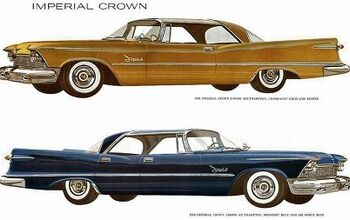Rare Rides Icons: The History of Imperial, More Than Just a Car (Part XI)

We return once more to Imperial today and find ourselves in 1967. The earlier portion of the Sixties was a turbulent time for Imperial, as the D-body soldiered on from 1957 through 1966 model years as the Imperial marque’s second-generation car. In 1967, Imperial’s lead designer Elwood Engel managed Imperial’s transition to a new shared platform. Say hello to C.
The flagship luxury Imperial no longer resided on its own special body-on-frame platform, as it migrated to Chrysler’s largest C-body for 1967. While the C platform was a unibody and certainly more modern than the outgoing D-body, the latter had long been known for granite-like strength and garnered Imperial its reputation as the driver’s luxury car of choice. Chrysler felt after the rest of its lineup made the switch to unibody for 1960 that it had enough engineering experience to switch Imperial over, too. The D-body was also fairly ancient by 1966, and Chrysler had introduced the modern C-body for its cars in 1965.
Imperial shared the C-body with all of Chrysler’s large cars of the period: Town & Country, Newport, 300, and New Yorker. While it was a new product direction for Imperial as a brand, it was certainly not the first time Chrysler’s flagship shared a platform with New Yorker and company. Recall that through the Forties and Fifties Imperial was essentially a trim variant of the largest Chryslers after it fell from its coach-built beginnings. The separation of the Imperial brand in 1955 was intended to put an end to sharing and similarity. Alas, money was tight, and sales no longer justified a unique platform for a single model.
Imperial’s wheelbase shrank by two inches to 127 with its swap to the C-body. Other dimensions withered too: Overall length was 224.7 inches, down from 227.8 the year prior. Width fared better, as shoulder-pad wearing occupants made do with 79.6 inches of overall width instead of 80. Overall height increased against the long and low grain of the era, from 55.8 to 56.7 inches. Imperial was still longer than any Chrysler, with its luxury-enhancing inches added out in front of the wheels. A comparable New Yorker in 1967 was just 218.2 inches long. The new platform helped reel in the Imperials heft, as the 1967 model topped out at 5,200 pounds over the D-body’s chunky 5,500. If either of those figures sounds outlandish for a passenger car, remember the current Cadillac Escalade weighs between 5,600 and 5,800 pounds.
Production moved with the new model, from Warren Avenue Assembly (Detroit) where it had been since 1963, and back to Jefferson Avenue Assembly, Imperial’s more historic production location. Imperials were also built at Belvidere Assembly in Belvidere, Illinois. It was the first time a production Imperial was built outside the Detroit metro area.
Imperial returned with four body styles, one more than in 1966. On offer were the two-door hardtop coupe and convertible, four-door hardtop, and the returning band member not seen since 1960: A most basic four-door sedan. Series nomenclature this year was CY1 (M, H) as Imperial lacked a “base” model designation once again, though there was a base Imperial without a secondary trim name attached. Mid-level trim was the Crown, and again flagship was LeBaron. Though it had a shared platform, Imperial had its own body panels and was not a badge swap of the New Yorker.
Elwood Engel continued the general Continental-like styling direction he’d established on the Imperial’s Exner-free rework in 1964. The most notable throwback was the full-width grille up front, with quad integrated headlamps that lost their housing of the prior year. Block lettering at the front returned to Imperial, now within the grille instead of atop it. The leading chrome strip along the hood and body side that was present on Imperial for years disappeared, as body chrome moved low on the door. Hard slab-sided body lines grew softer and headed toward the fuselage design that would Define Chrysler for much of the Seventies. Wheels were not as deeply inset into the body, as late Sixties cars moved away from “bathtub on piano wheels” setups. Door handles became push button and grab handle design, and were no longer flush like the prior year. Wrap-around windshields, a detail of the past, were gone, and the roof treatment was a bit thinner and more glassy. Also gone was the faux continental kit bulge at the trunk. The Imperial’s new rear end was much less rocket inspired and went for a horizontal slats look with a grille that mimicked the front. Carried over was the large imperial logo in the center of the rear, which functioned as a fuel door.
Interior styling wasn’t far removed from the year prior. The dash was still sweeping and horizontal, though now was angled away from front passengers instead of towards them. Dials and controls were all horizontal in design, with buttons and switches that were more integrated into the dash rather than on separate pods near the driver. Vents became integrated into the dash instead of mounted underneath. The steering wheel was exactly the same as in 1966.
The incredibly rare Ghia-built Imperial Limousine was no more and moved to a more practical type of construction and location. Chrysler hired the Ambruster-Stageway company to build its Imperial limousines. A name change meant the special limo was now called Imperial LeBaron Limousine; the historic Crown Imperial name was dropped. Based in Fort Smith, Arkansas, Ambruster was a company famous for making six-door limos used for airport transportation, and other very long commercial vehicles. For limousine orders, Ambruster added 36 inches to Imperial, most of which went to the car’s midsection. There was also a short extension between the rear door and wheel well. Middle row passengers faced the rear in the 1967 Limousine, unlike prior limos that used a jump seat setup. Between the rows was a sideboard for drinks. The resulting 260.7-inch car was longer than a Ghia car ever reached, and for marketing purposes was also longer than a Cadillac Series 75.
A new option to Imperial this year was Mobile Director, available only on the Imperial Crown coupe. The executive option allowed the front passenger seat to face the rear, where a table and desk lamp folded over the back seat. The general idea was an executive could work facing the rear while his driver headed toward the office. Said executive would sit in the back seat if he had a secretary with him, who could do work in the rear-facing front seat. The unusual option package cost $317.60 in 1968, or $2,558 adjusted. It was so pricy that only 81 Crown Coupes were fitted with Mobile Director, and the option was dropped after 1968.
Carried over from 1966 was the new Wedge V8, the 440 (7.2L). The big-block was paired to the same three-speed TorqueFlite A727 as before. In other engineering news, power brakes with front discs were standard. No longer standard was dual exhaust, which was only offered with the TNT engine package. TNT added 15 horsepower to the 440 via twin inlets on the air cleaner.
The new platform and redesign improved Imperial’s sales in 1967 by about 28 percent, as Chrysler sold 17,614. By 1968 Chrysler was winding down its first generation of the C-body. Aside from Imperial, its C cars had been on sale since 1965, and Chrysler was preparing to head a new styling direction. For 1968 the Imperial’s series was renamed DY1 (M, H), and little was changed from the model’s debut year. Bumpers retained their battering ram detailing, which extended into revised corner lamps that wore the grille’s slatted design. The resulting look was more modern and streamlined than 1967, with a simpler and larger grille design that was split down the middle but only by a small trim strip. Buyers of 1968 went without a proud hood ornament, as the Imperial fowl moved into the middle of the grille. The rear-eagle fuel door was now made of metal instead of plastic. The base model unlabeled Imperial ended as a single-year offering, as it was canceled and the four-door pillared sedan became a Crown instead. Customers who wanted an Imperial convertible bought in during 1968, as the model was about to fall by the wayside forever.
Sales dropped as customers anticipated fuselage looks the following year, to 15,361. Of that figure, 1,887 were base Crown sedans, and 8,492 were Crown hardtops. The unpopular Crown convertible sold only 474 examples in its final outing, while the top-tier LeBaron four-door sold 1,852. Pricing for a base sedan was $5,653 ($46,077 adj.), and it was a small step up to the Crown hardtop at $6,114 ($49,835 adj.). Crown coupes asked $5,721($46,631 adj.), while a convertible was much more dear at $6,522 ($53,160 adj.). The LeBaron made no apologies for its $6,939 ($56,559 adj.) ask.
By 1968 the early Sixties Continental styling of the Imperial looked very upright and conservative among other large car competitors that had gone longer, lower, and wider over the decade. The following year saw an all-new Imperial once more, as Chrysler introduced its enormous Fuselage Look Imperials of 1969. More on that in Part XII.
[Images: Imperial]

Interested in lots of cars and their various historical contexts. Started writing articles for TTAC in late 2016, when my first posts were QOTDs. From there I started a few new series like Rare Rides, Buy/Drive/Burn, Abandoned History, and most recently Rare Rides Icons. Operating from a home base in Cincinnati, Ohio, a relative auto journalist dead zone. Many of my articles are prompted by something I'll see on social media that sparks my interest and causes me to research. Finding articles and information from the early days of the internet and beyond that covers the little details lost to time: trim packages, color and wheel choices, interior fabrics. Beyond those, I'm fascinated by automotive industry experiments, both failures and successes. Lately I've taken an interest in AI, and generating "what if" type images for car models long dead. Reincarnating a modern Toyota Paseo, Lincoln Mark IX, or Isuzu Trooper through a text prompt is fun. Fun to post them on Twitter too, and watch people overreact. To that end, the social media I use most is Twitter, @CoreyLewis86. I also contribute pieces for Forbes Wheels and Forbes Home.
More by Corey Lewis
Latest Car Reviews
Read moreLatest Product Reviews
Read moreRecent Comments
- ChristianWimmer 2018 Mercedes A250 AMG Line (W177) - no issues or unscheduled dealer visits. Regular maintenance at the dealer once a year costs between 400,- Euros (standard service) to 1200,- Euros (major service, new spark plugs, brake pads + TÜV). Had one recall where they had to fix an A/C hose which might become loose. Great car and fun to drive and very economical but also fast. Recently gave it an “Italian tune up” on the Autobahn.
- Bd2 Lexus is just a higher trim package Toyota. ^^
- Tassos ONLY consider CIvics or Corollas, in their segment. NO DAMNED Hyundais, Kias, Nissans or esp Mitsus. Not even a Pretend-BMW Mazda. They may look cute but they SUCK.I always recommend Corollas to friends of mine who are not auto enthusiasts, even tho I never owed one, and owned a Civic Hatch 5 speed 1992 for 25 years. MANY follow my advice and are VERY happy. ALmost all are women.friends who believe they are auto enthusiasts would not listen to me anyway, and would never buy a Toyota. They are damned fools, on both counts.
- Tassos since Oct 2016 I drive a 2007 E320 Bluetec and since April 2017 also a 2008 E320 Bluetec.Now I am in my summer palace deep in the Eurozone until end October and drive the 2008.Changing the considerable oils (10 quarts synthetic) twice cost me 80 and 70 euros. Same changes in the US on the 2007 cost me $219 at the dealers and $120 at Firestone.Changing the air filter cost 30 Euros, with labor, and there are two such filters (engine and cabin), and changing the fuel filter only 50 euros, while in the US they asked for... $400. You can safely bet I declined and told them what to do with their gold-plated filter. And when I changed it in Europe, I looked at the old one and it was clean as a whistle.A set of Continentals tires, installed etc, 300 EurosI can't remember anything else for the 2008. For the 2007, a brand new set of manual rec'd tires at Discount Tire with free rotations for life used up the $500 allowance the dealer gave me when I bought it (tires only had 5000 miles left on them then)So, as you can see, I spent less than even if I owned a Lexus instead, and probably less than all these poor devils here that brag about their alleged low cost Datsun-Mitsus and Hyundai-Kias.And that's THETRUTHABOUTCARS. My Cars,
- NJRide These are the Q1 Luxury division salesAudi 44,226Acura 30,373BMW 84,475Genesis 14,777Mercedes 66,000Lexus 78,471Infiniti 13,904Volvo 30,000*Tesla (maybe not luxury but relevant): 125,000?Lincoln 24,894Cadillac 35,451So Cadillac is now stuck as a second-tier player with names like Volvo. Even German 3rd wheel Audi is outselling them. Where to gain sales?Surprisingly a decline of Tesla could boost Cadillac EVs. Tesla sort of is now in the old Buick-Mercury upper middle of the market. If lets say the market stays the same, but another 15-20% leave Tesla I could see some going for a Caddy EV or hybrid, but is the division ready to meet them?In terms of the mainstream luxury brands, Lexus is probably a better benchmark than BMW. Lexus is basically doing a modern interpretation of what Cadillac/upscale Olds/Buick used to completely dominate. But Lexus' only downfall is the lack of emotion, something Cadillac at least used to be good at. The Escalade still has far more styling and brand ID than most of Lexus. So match Lexus' quality but out-do them on comfort and styling. Yes a lot of Lexus buyers may be Toyota or import loyal but there are a lot who are former GM buyers who would "come home" for a better product.In fact, that by and large is the Big 3's problem. In the 80s and 90s they would try to win back "import intenders" and this at least slowed the market share erosion. I feel like around 2000 they gave this up and resorted to a ton of gimmicks before the bankruptcies. So they have dropped from 66% to 37% of the market in a quarter century. Sure they have scaled down their presence and for the last 14 years preserved profit. But in the largest, most prosperous market in the world they are not leading. I mean who would think the Koreans could take almost 10% of the market? But they did because they built and structured products people wanted. (I also think the excess reliance on overseas assembly by the Big 3 hurts them vs more import brands building in US). But the domestics should really be at 60% of their home market and the fact that they are not speaks volumes. Cadillac should not be losing 2-1 to Lexus and BMW.










































Comments
Join the conversation
It should be mentioned that the 67/68 Imperials were touted as all new but one look at a 65 Newport or New Yorker and one can see where the hood, deck lid and roof line came from. Still a good looking car though.
My garage is honored to provide a home for our 1968 Crown 4 door hardtop. A frost green original capped by the stunning beauty of the original antique green vinyl roof. We bought this car in January 2019 in Illinois, and drove it home to Northern Nevada through the dead of Winter's ice storms and blizzards. Other than one of the 38 year old tires blowing out, attesting to the reverse lug nut threads, we had no problems and then incredibly comfortable ride home. I love all the looks and comments we get every time we take her out. And I am grateful that this version is a tad shorter then the previous bodies, as we now have 2 inches of clearance front and rear in the garage. Very nice coverage for one of the Great all the time American Automotive masterpieces.